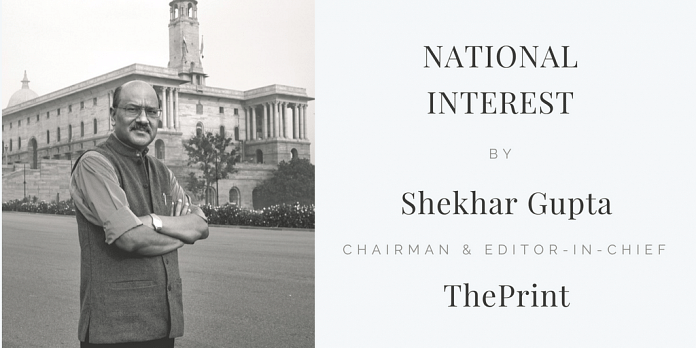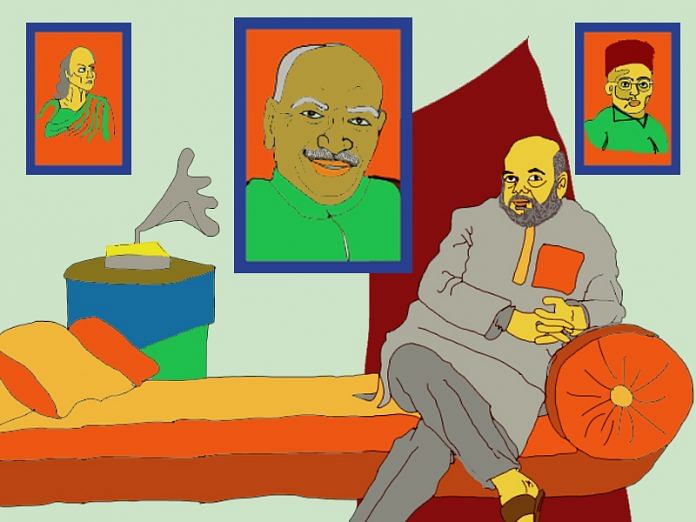The living room in BJP president Amit Shah’s residence has minimalist furnishings, like the homes of old-generation politicians. He speaks to visitors from his favourite spot on the middle sofa, his back to the wall. A visitor notes the two framed portraits on that wall: Chanakya or Kautilya to the left of your eye, and Savarkar to the right. Those two deities determine his politics — Kautilya for political craft, and Savarkar for his Hindutva-nationalism ideology.
Shah could, however, add a third portrait to that wall, ideally in the space between Kautilya and Savarkar. It would have to be a pucca Congressman. Because while his political and state power, and philosophical impulse comes from the two already there, his political style and authority over his own party harks right back to the heyday of late Congress president (1964-67) K. Kamaraj. Not since Kamaraj had cabinet ministers trooped into the ruling party president’s office, to read own report cards or, offering to resign to devote time to party work. The drama is currently playing out as a cabinet reshuffle looms.
 Not since Kamaraj in his first reign, 1964-67, has a full-time ruling party president has wielded such power. For clarity, we are only talking of full-time party presidents, as different from Congress prime ministers who were also party presidents or a party president who had an “appointed” prime minister with limited powers. Other full-time ruling party presidents, Dev Kant Barooah, Chandra Shekhar (Janata), and those who held the same position in the BJP during Vajpayee years had limited powers and therefore, do not make the cut.
Not since Kamaraj in his first reign, 1964-67, has a full-time ruling party president has wielded such power. For clarity, we are only talking of full-time party presidents, as different from Congress prime ministers who were also party presidents or a party president who had an “appointed” prime minister with limited powers. Other full-time ruling party presidents, Dev Kant Barooah, Chandra Shekhar (Janata), and those who held the same position in the BJP during Vajpayee years had limited powers and therefore, do not make the cut.
Shah’s power is more unique because Narendra Modi doesn’t owe his rise to him. It is the other way around. Shah was Modi’s personal choice after he became the prime minister in 2014. You can search hard, with the highest degree of suspicion as medical pathologists like to say, but it isn’t possible to see an issue where he may have worked at cross-purposes with the Prime Minister. Nor is there evidence yet of his having been overruled or a decision thrust on him.
Also Read: This BJP govt is easy to understand. If you read what Modi, Shah, Nadda read when they were young
“Just what were they smoking, drinking, eating, thinking, when they did so?” I had asked in a National Interest (Lose-Lose, July 13, 2013) when the BJP made him in charge of their U.P campaign. For sure, I was proven wrong as he delivered 73 seats (including two with allies) out of UP’s 80. The reason, in retrospect, was an assumption I made erroneously: that the BJP once again wanted to build an NDA government in the image of Atal Bihari Vajpayee’s. That the party’s approach will be inclusive, soft Hindutva without upsetting the centrist status quo. Only if that belief was true, was the conclusion about Shah being a bad choice for Uttar Pradesh going to be correct. As politics unfolded, I was proven unwise to make that assumption.
Subsequent politics, has further underlined how wrong that assumption was. Far from building one more government in Vajpayee’s image, the Modi-Shah view was to build a “genuine” and unapologetic BJP-RSS government. There was also an understanding that Vajpayee’s government was hardly the BJP’s as a large number of key ministries were with non-RSS people. It doesn’t just apply to ministries given to allies like George Fernandes in defence, but also to Jaswant Singh, Yashwant Sinha, Rangarajan Kumaramangalam, Arun Shourie and others who were not ideological natives of the RSS and the BJP.
That government is now seen to have been true neither to ideology nor the party. The current dispensation belongs to the other end. Where the party doesn’t have talent for a job with requisite ideological purity, it is no longer willing to explore outside to find it. The party would give power only to the absolutely pure, or those who have paid their dues through the decades. This has been driven unforgivingly by Shah.
This BJP/NDA government, in that sense, is completely different from the earlier one. That the BJP now has a majority of its own makes a difference, but you can be quite sure if L.K. Advani, or any of the other older BJP leaders Delhi is familiar with, had been given this majority, they would not have built a government with such uncluttered ideological commitment. Modi underlined this with his choice of RSS pracharaks and a young faithful as chief ministers of Haryana, Jharkhand and Maharashtra though they were political lightweights. Shah then moved in with his preferred choices, Vijay Rupani in Gujarat, Yogi Adityanath in Uttar Pradesh and Ram Nath Kovind as President of India. These were not in defiance of the Prime Minister. Just that the initial choice was made by Shah who kept each secret from the party.
Also Read: Amit Shah & Modi are playing with a fire that doesn’t distinguish between Muslim & Hindu
On Gandhi Jayanti in 1963, Kamaraj caused a political upheaval by resigning as Tamil Nadu chief minister, to rededicate himself to party work. In his wake, six cabinet ministers and five other chief ministers resigned too. It saw heads like Morarji Desai and Jagjivan Ram roll. His was a brutal internal clean-up and was called Kamaraj Plan though he wasn’t even the party chief yet. It has faded from memories now, but it was for long a storied purge of Stalinist dimensions, though bloodless and “voluntary”. It kept political cartoonists and satirists busy for a long time. Nehru, then in decline, was so impressed (and possibly insecure) that he asked that Kamaraj be made party president. He came to his elements after Nehru’s death, ensuring the swearing-in of Lal Bahadur Shastri first and Indira Gandhi next, destroying the ambitions of well-entrenched Morarji Desai. During these years, 1964-67, the most powerful Congressmen chased him for favour and his fabled reply “paarkalam” (let’s see) in Tamil joined India’s political dictionary.
We don’t yet know if Shah has such a favourite line, but the rest of the Kamaraj playbook is all there. Ministers line up before him, not the prime minister, who has given him this power. And he would persuade them to “volunteer” resignations to rededicate themselves to party work. They will all come out smiling, claiming to be loyal party workers with no other expectations even as their hearts bleed. They work on presumption now that the Modi-Shah leadership will continue till 2024 and grow more clout as time passes. They would keep hoping that Shah notices their contribution to party work and brings them back at some point.
For half a century, Delhi had not seen a truly powerful ruling party president. It is taking its time making adjustments. Shah has made other significant changes. The BJP’s parliamentary party meeting now takes place in the party office, and the prime minister comes there to attend. This changes the long-established practice of holding these meetings in the Prime Minister’s house for his convenience. The Cabinet, chief ministers, even the heads of the most powerful government departments and agencies now acknowledge where power lies, besides the prime minister’s office. They are making adjustments accordingly. This reshuffle will further reaffirm this new normal.
Shekhar Gupta is Editor-in-Chief of ThePrint.
Also Read: Karnataka affirms Amit Shah as the most powerful Indian party chief in half-a-century







If you think there was no powerful party chief between Kamraj and Amit Shah, you are either suffering from memory loss, or you don’t have the guts to name Sonia Gandhi and her son.
Remember, the entire cabinet including the PM couldn’t utter a word in front of Sonia Gandhi. Remember when a mere MP could tear apart a cabinet resolution to score political points, just because that particular MP is son of party president Sonia Gandhi.
If Sonia Gandhi wasn’t a dominant party president, I don’t know who would be.
read the article properly. he excluded Sonia Gandhi as she was the real power and she has chosen the pm
Happy to remember our King Maker Shri. K. Kamaraj at this scenario, that too from the Northern Politics. Its great to know that, the present Political Heads are so admirer to Kamarajar, His was a brutal Interior Clean up and later it was known as Kamaraj Plan. , though he was not in the Chair of Party Chief, that time. We are glad to know that,
the present “Modiji_Shaw” team are followers of His polices in Politics Hard core good decision. and glad to know that, we can expect a clean polices in Politics, here after, with out any external interfere.
Thank you so much for writing some thing about Kamraj as lot in the political circles in north will not be aware of. Even the political journalists in NDTV, Republic, Indiatoday, CNNIBN would not be even knowing his name.
Well reasoned read. Reflects what good journalism ought to reflect. Refreshing after a long long time especially coming from ‘Luytens’ side of the fence ?
Unusually drab from Shekhar. Subject is rich but lack of customary zest and wit this week.
How come after Kammaraj it is Amitshah when an AICC chief controlled the PMO of Manmohan Singh for 10years from the kitchen of No10 Janpat?